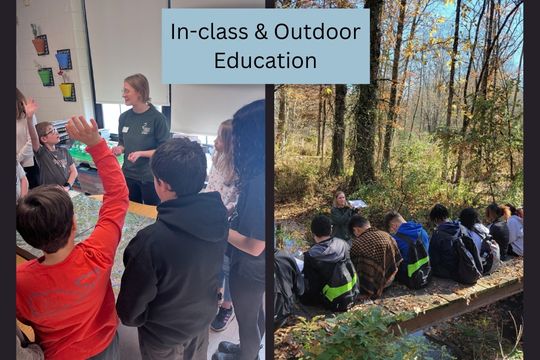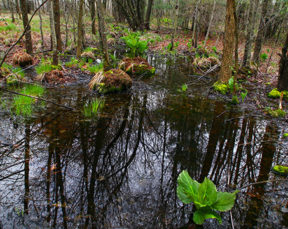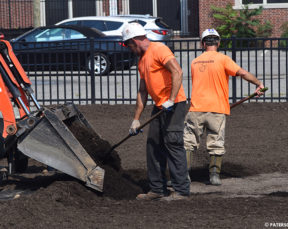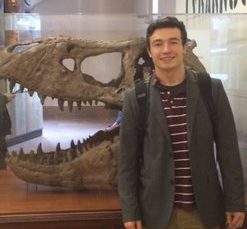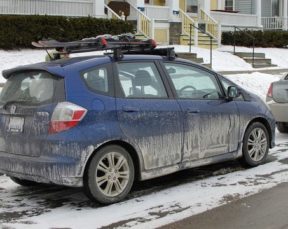By P.C. ROBINSON Editor, New Jersey Hills Media Group
Editor’s note: This story was produced as part of the Northern New Jersey Media Collaborative Project “Stormwater Matters,” a project focusing on stormwater management solutions in the state.
While it’s true that “you don’t know what you’ve got till it’s gone,” as that classic Joni Mitchell folk song goes, it’s also true that you don’t know what you’ve got till you’re shown.
It’s a premise shared at the Great Swamp Watershed Association, the Harding-based environmental group borne out of the need to save the Great Swamp from turning into a massive jetport 60 years ago.
It’s certainly a premise known too well by Hazel England, the association’s director of education and outreach and Sandra LaVigne, director of water quality programs, who have been educating students on the need to preserve and protect water quality both upstream and down.
While the struggles may look different no matter what part of the 20-mile river one lives at, they remain the same – protecting and ensuring water quality from tributary to tap – although it’s an entirely different perspective downstream, according to England.
The gist is to educate youngsters in urban areas who may not be aware of the need to not only preserve water quality, but find ways to ensure that water is still clean by the time it ends its destination in household sinks. And, it empowers them to understand that, no matter how big the problem, there are things they can do to help.
According to England, when they go in to discuss water quality, say, in Newark, for example, students’ “number one thought is about land in the water – what’s coming from the pipes.”
That changes once they’re introduced to that other world, an education more kids are receiving now that the state, post-Covid, revised its curriculum so entire classes are given identical instruction.
According to England, that means a class field trip may include not the usual 20 students encountered before the pandemic, but perhaps an entire class of 60 about. However, while it imposes some changes and extra staff work, it does pay off, as more kids get the message – and are left in awe at what they learn.
“Sometimes you can just see a spark switch on,” England said.
The impact can be immense, as the Great Swamp women found out when educating students at Orange High School. Many of the kids were immigrants, primarily speaking Spanish or Creole. To better make the connection, they enlisted bilingual Kean University interns to help translate.
Another eye-opener was a field trip to the Great Swamp Wildlife Refuge for water testing.
“They’d never been anywhere like it or seen anything like it,” said England.
Better yet, while there, they could hold crayfish or dragonfly larva, saw a wood frog, a harvestman – known more familiarly as a Daddy Long Legs – and a bald eagle in flight.
“They were equally excited about all of that,” she said.
Similar reactions were made by Paterson’s International High School students doing water testing at the Great Falls National Historic Park in Paterson.
On this one particular day, students took water from both above and below the falls, bringing samples back to test for bacteria. During the trip they could also look for macroinvertebrates like crayfish.
Paterson students also conducted field research in Molly Ann Brook, a Passaic River tributary that trickles behind John F. Kennedy High School on Paterson’s west side.
But if students feel awe at Mother Nature, they also can feel her pain.
Thanks to an aging system and enormous expense to correct it in one fell swoop, Paterson’s sewer and water infrastructure is a mess. Sewage floods stormwater basins, stormwater floods into basements.
According to England and LaVigne, kids can very often get five feet of water in their basement thanks to flooding after one thunderstorm. They also have more days off from school than they do snow days, thanks to flooding that impacts their homes or schools.
Students think they have a way to fix the problem, England and LaVigne said: Split off the stormwater/sewage runoff by using two not one pipe for the city.
There’s just one problem. According to LaVinge, “that would cause hundreds of billions of dollars.”
Unfortunately, nothing is going to change overnight. According to LaVigne, solutions “might not be easy and they’re complicated, and they take a long time.”
Still, there are some things students can do to stay engaged, she said. One is to adopt local storm catch basins, ensuring they are cleared to avoid flooding.
England and LaVigne are firm in insisting they are not going into an urban area to tell the locals what to do. Instead they are offering their services should they be wanted.
“As we build an understanding of what the issues are we’re connecting to local organizations that are already in the town. “We’re not coming in to solve all the downstream problems. We’re working the length of the river looking to build consensus.”
LaVigne said they also reach out to various coalitions, like the Paterson Flood Fighters, and PatersonSMART, a partnership of more than 20 members, created in 2015 to address flooding and combine sewer overflows in the city and to introduce green infrastructure, like rain gardens. Other partners included the Rutgers Cooperative Extension and Passaic Valley Sewerage Commission.
Slowly but surely, however, efforts are being made to improve the problem.
In December, 2022, the Passaic Valley Water Commission – not to be confused with the Passaic Valley Sewerage Commission – received from the Passaic County Board of Commissioners four engineering contracts totaling $1 million to initiate studies eyeing upgrades to the city’s aging cast iron water pipes.
According to a statement issued by the Commission, the areas that have systemic taste, odor and color issues will be given high priority. Also evaluated will be water demand and pipe capacity to ensure pipes are sized properly for existing and future generations.
The Great Swamp Watershed Association protects and improves the health of the Passaic River through science, education, land preservation and stewardship, and advocacy. It is the Waterkeeper Alliance Affiliate for the Passaic River. For more information visit www.greatswamp.org
